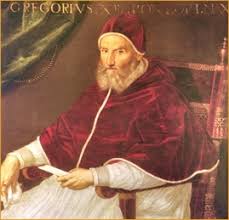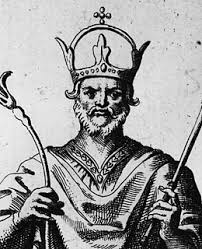
INVESTITURES STRUGGLES
Church v Empire
When Pope Leo III placed a crown on the head of Charlemagne on Christmas Day,
800AD and declared him the first Holy Roman Emperor, the controversial act not
only established the Holy Roman Empire (or restored it after its mainly pagan
predecessor had lapsed in 476) – it also set off a succession of disputes over a
single question: who was the superior authority - the Emperor or the Pope? The
Pope, argued his supporters, had the authority to crown an Emperor so must be
superior. The Pope, ran the counter-argument, had yielded his superiority and
transferred it to the Emperor by the act of coronation.
The disputes raged hot and cold for centuries but at no point were they more
bitter and contentious than during what has become known as the Investitures
Struggles. The Struggles began as a dispute over the appointment of Popes and
the standards to be met by bishops and clergy. In reality it was a bitter
continuation of the contest for supremacy between Pope and Holy Roman Emperor
and the involvement of the aristocracy in that contest. The main struggle took
place between 1059 and 1095. Its end was technically formalised in 1122 at the
Concordat of Worms where it was agreed that the Cardinals would elect the Pope
in the presence of the Emperor. Even then, disagreements continued.
Preceding the struggles was an early eleventh century invasion of the lower half
of the Italian peninsula by the Normans. Catholics living under their rule felt
oppressed and appealed to Pope Leo IX for help. A papal army led by Leo himself
attacked the Normans in 1053 but suffered defeat and Leo was captured. After
reluctantly conceding the legitimacy of the Norman territorial gains he was
released but died shortly after returning to Rome in 1054. Leo had been the
first Pope to declare a need to revise the rules relating to clerical behaviour.
He believed priests marrying and church appointments made in return for money or
favour (simony) were bad practices and should be done away with. This was highly
controversial and a clear factor leading to the Struggles. Leo’s papacy was
eventful in other respects and included the Great Schism: separation of
Christianity into western and eastern sectors with the west ruled from Rome and
the east from Constantinople.
By 1059 Pope Nicholas II occupied the papal throne and the Investitures
Struggles were fully unleashed when he issued an “Election Decree”, requiring
Popes to be elected only by Cardinals and to eliminate any input from bishops,
priests, the wider nobility, people of Rome and, very specifically and
significantly, the Emperor. Alexander II succeeded Nicholas in 1061 before any
new method of election could be put in place but after his death in 1073 Gregory
VII was “elected” Pope by popular acclamation at the funeral of his predecessor
– a previously unheard of method of appointment and a clear defiance of the
Election Decree.

Gregory shared Leo’s views on clerical marriage and simony and energetically set
about reforming the Church. He and his supporters had looked back and seen a
gradual erosion of the stature of the papacy since the last major reorganisation
by Pope Gregory I (590-604). Gregory I had wielded total power but much of it
had been surrendered to the Emperor, King or lay authorities over the centuries.
They concluded that a major reason was that church canon had accumulated
haphazardly, was not accessibly codified and had fallen into disuse. Gregory VII
summarised it in a small, easily distributed booklet and ensured it was put in
the hands of all clergy. This re-affirmed the doctrine of strict celibacy and
the proscription of simony. At the same time he issued a list of twenty-seven
papal prerogatives which included the right to excommunicate Emperors and even
depose them.
The Emperor at the time, Henry IV, was not impressed. Gregory had his supporters
but so did the Imperialists who deplored the idea of placing any authority above
the Emperor. The showdown came in 1075 when Henry attempted to replace a
“troublesome” and independently-minded Archbishop of Milan with an appointee
over which he had more control. The Pope warned Henry against such a move and
threatened excommunication. The Emperor responded aggressively by gathering
German bishops and having them sign a declaration that Gregory was a false Pope
due to his unorthodox “election”. On reading the declaration Gregory immediately
excommunicated and deposed the Emperor. The gloves were off. The population was
in turmoil. Who do they support? The Pope (what Pope??) or the Emperor (what
Emperor??)?
Christianity was the very bedrock of western civilisation in the 11th
century, with the Papacy and the Empire its two executive arms. A three-pronged
argument was now raging: the election of Popes, the controversy launched by Leo
over clerical behaviour and, most vehemently, the Pope
v Emperor pecking order.

While the disputes were shaking the church to its very foundations, sections of
the lay community saw them as an opportunity to further their own interests.
Trouble was already brewing in Germany. Henry, known as King rather than Emperor
since being deposed, had deprived wealthy magnates of their influence, and the
peasants of Saxony feared being made serfs of the King who was building castles
on their borders. Magnates and peasants both began asserting themselves on
hearing of Henry’s excommunication and knowing they could rely on the Pope for
support. Meanwhile a chance meeting between King Henry and Pope Gregory gave the
King an opportunity to beg forgiveness for doubting the Pope’s legitimacy. This
required the Pope to decide between ignoring the repentance in support of his
allies in the dispute (the magnates and the Saxon peasants) or adhering to his
priestly obligation to forgive when repentance is shown. He had little choice
but to follow the latter course.
Feeling betrayed by the Pope’s action, the magnates now moved without papal
support. They declared the deposition of Henry final and elected Rudolf of
Swabia King in his place. Civil war broke out between the supporters of the
respective “Kings”. The Pope now saw himself as a mediator and in 1079 sent
legates to resolve the matter, requiring Henry and Rudolf to meet with the
legates under threat of excommunication. The meeting was set for early 1080,
shortly after Henry had won a battle against the Saxon peasants. Encouraged by
his success Henry chose not to attend the meeting. Gregory deposed him for the
second time and officially recognised Rudolf as King. Not to be outdone, Henry
now deposed Pope Gregory. Such an act required signatures from an assembly of
German bishops. Only a small group gathered as many did not recognise the King’s
right to depose Popes.
To add yet another complication Rudolf was killed in battle that same year.
Henry now re-claimed the throne for himself but remained off-side with Pope
Gregory and the brutal war continued for another four years, now King v Pope
rather than King v King. In 1084 Henry’s forces captured the greater part of
Rome. Thirteen cardinals deserted to Henry’s cause and only the Normans saved
Gregory by escorting him to safety in Salerno. Meanwhile, Henry had Clement III
enthroned as Pope and Clement in turn crowned Henry IV as Emperor. The pendulum
had swung wildly in Henry’s favour. The Normans, bemused spectators to this
point, now viewed Rome as a haven for the enemy and they returned from the south
to pillage the city, burning a large part of it. The civil war was indeed
brutal. While Henry, as the monarch, had access to the more powerful
fighting force, he was contending not just with the papal supporters and the
Normans but also forces controlled by wealthy magnates from Bavaria and Saxony
as well as other factions opposing the King. Parallel with the war on the ground
was a “war of letters” with intellectuals on both sides penning persuasive
arguments. A constant theme being expressed was the “divine” status of the King:
God’s representative in all matters secular with the Pope’s authority limited to
the spiritual realm. Papal supporters strongly rejected this.
In 1085 the tumultuous life of Pope Gregory came to an end when he died in exile
at the age of 70. His reforming cause did not die with him. His supporters were
not intimidated by Henry’s superior force and refused to support the election of
Clement III even though he had been enthroned in St Peter’s. They proceeded to
elect Victor III, and on Victor’s death elected Urban II who combined strong
support for the Gregorian reforms with a flexibility that regained the support
of the bishops and cardinals who had deserted Gregory. Wide support for Urban
left Clement’s “papacy” without foundation (if it ever had one).
A
master stroke by Urban in 1095 was to preach a crusade to reclaim Jerusalem.
This was an act of enormous significance and cemented his leadership in temporal
as well as spiritual matters. The warring sides now had a common enemy: the
Moslems occupying the Holy Land. It was
Henry’s turn to watch from the sideline. Urban’s single act had united
Christendom throughout western Europe. Henry’s dilemma was that it had always
been the duty of the Emperor to protect the church against pagans (at least,
since Charlemagne), but throughout the Struggles the Emperor (or, mostly, the
King) had been fighting the Pope so was in no mood to defend him or declare
support for his crusade. This left the Pope responsible for protecting the
crusaders throughout their tortuous journey into pagan lands. The crusade was
successful in that it regained Jerusalem, albeit temporarily, from the Moslems
and secured it for Christianity. The supremacy of the Papacy which Gregory had
sought to assert was finally accomplished. Throughout Urban’s reign the Emperor
(or King) had lost all religious authority, even in Italy and Germany.
The end was now in sight for this sorry chapter in western civilisation. As
noted in the opening paragraph the right of the cardinals to elect the Pope was
codified in the Concordat of Worms in 1122. This didn’t close the book on the
Struggles as the status of the Papacy continued to oscillate in the eyes of the
population. Clerical behaviour relating to celibacy and simony showed no
permanent improvement. Secular rulers were later finding ways of appointing
bishops of their choice and there were periods when the Emperor again wielded
authority over the Pope. These issues and many others were addressed by Pope
Innocent III, (1198-1216). After Innocent’s death, St Francis of Assisi, and
more importantly, his followers, continued to rebuild the reputation of the
church. One follower in particular (or perhaps mentor) became Pope Gregory IX in
1230 and his pontificate has historically been seen as the end of the
Investitures Struggles.